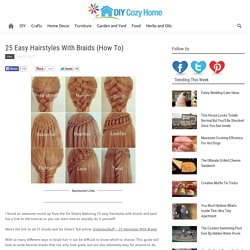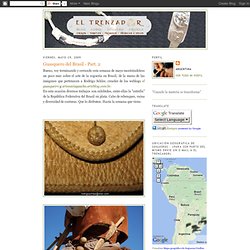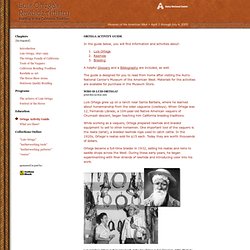

Jack Armstrong Braiding - Multi string side button.
Whips. Buttons. Winterarbeit in Südtirol 1/3. Winterarbeit in Südtirol 2/3. Winterarbeit in Südtirol 3/3. 25 Easy Hairstyles With Braids (How To) I found an awesome round up from the Six Sisters featuring 25 easy hairstyles with braids and each has a link to the tutorial so you can learn how to actually do it yourself!

Here’s the link to all 25 braids and Six Sisters’ full article: SixSistersStuff – 25 Hairstyles With Braids With so many different ways to braid hair it can be difficult to know which to choose. This guide will look at some favorite braids that not only look great, but are also extremely easy for anyone to do. Hairstyles – Double Y Braid – Braided Top Knot – Braided Bun – Four Stranded Plait – Boho Crown Double Y Braid The Double Y Braid looks amazing and looks like it took ages to do. Start by sectioning the hair into four parts, two at the back, and two either sides of the shoulders. When braided the front two sections of hair can be bought around to the back of the head and wrapped around, then secured in place using pins. Kamalo Rennano. Tim George and the Western Art of Rawhide Braiding.
Jack Armstrong - Multiple string ring knot video. El Rincón del Soguero. Youtube.com Videos - gaucho knot Videos. How to Tie a Paracord Gaucho Knot More knotty stuff on my blog: This video will show how to tie a Gaucho knot using a length of paracord, Jumbo Perma-Lok lacing... stormdrane Length: 7:37 Views: 452267 Tags: Spanish Ring Knot (and gaucho primer) The needle I'm using is the long jumbo Perma-lok.

Cuero. Mayo 2009. Dado que he me dedicado a escribir bastante sobre la sogueria y de los sogueros de otras latitudes, con este postage me concentro nuevamente en hablar sobre la soguería criolla de nuestro país.

Para eso que mejor que exponer algunas imágenes, sencillamente preciosas y que me dan mucho honor en mostrarlas de quienes participaron del 34º Concurso de Artesanías Tradicionales Argentinas "El Cuarto de las Sogas" llevada a cabo en el marco de la 122º Exposición de Ganadería, Agriculturae Industria Internacional- La Rural 2008 -. Las imágenes en su totalidad las extraje del sitio web oficial de la Tradición Gaucha Argentina al cual cual recomiendo que entren, sobre todos los lectores extranjeros de este blog, para que conozcan un poco más de la tradición gaucha de mi país. Los ganadores del certamen del año pasado fueron: 1er. PREMIO:- Don Marcos Díaz. 1ra. 2da.
Doug Groves Video: Rawhider Twister & Braider (for lassos) Braids. Braiding is a easy, medieval and quite practical way to make laces, straps, ties, and many other narrow wares.

There are far more possibilities than just the simple 3-strand braid that everyone knows. Although there are many ways to make cords and narrow strips of fabric, this discussion is limited to a few of the most common braids made from a set of elements and using no equipment. Basic Flat Braid The elements are divided into two equal or nearly equal groups, and the outside element from one group is carried over the rest of that group and added to the inside of the other group.
Type: 3-strand This is the "basic" braid, virtually ubiquitous in time and place. Construction: over 1 Examples: Medieval London- worsted wool, each element composed of 5 strands (Crowfoot et al. 1992) Medieval York- interesting example made from hair moss (Walton 1989) Medieval York- as part of a more complex diamond mesh structure (Walton 1989)
Bernie46's Channel. 12 strand round plait. Bottle Sling. The Rams Skull Press - Aus Bushcrafts, Leather and Knotting Titles. NW Profiles: Braided Rawhide. Luis Ortega’s Rawhide Artistry: Braiding in the California Tradition. In the guide below, you will find information and activities about: A helpful Glossary and a Bibliography are included, as well.

The guide is designed for you to read from home after visiting the Autry National Center’s Museum of the American West. Materials for the activities are available for purchase in the Museum Store. Luis Ortega grew up on a ranch near Santa Barbara, where he learned about horsemanship from the older vaqueros (cowboys). When Ortega was 12, Fernando Librado, a 104-year-old Native American vaquero of Chumash descent, began teaching him California braiding traditions. While working as a vaquero, Ortega prepared rawhide and braided equipment to sell to other horsemen. Ortega became a full-time braider in 1932, selling his reatas and reins to saddle shops across the West. Luis and Rose Ortega in their sales booth at the Cow Palace in San Francisco, 1964. In 1938, Ortega married Rose Smith, who helped run her husband’s business. Justin McInteer, Autry National Center.